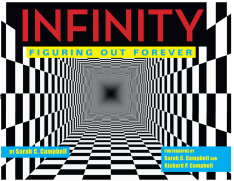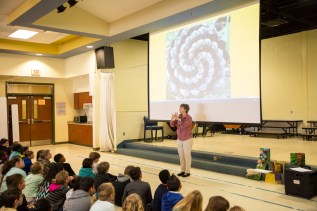Leeches, bedbugs, and plagues! These books focus on some of the plants, pests, and parasites that share our home and, in some cases, our body.

Bugged: How Insects Changed History by Sarah Albee, illustrated by Robert Leighton
This book is filled with “death, disease, and disgusting details…” There are bugs that swarm, bugs that devour crops, and bugs that transmit plagues. There are also stories about insects that have built entire industries (think: silkworms, honeybees). The author even provides a “TMI” warning for some sidebars, so squeamish readers can avoid the grossest (and coolest) stuff.

Itch!: Everything You Didn’t Want to Know About What Makes You Scratch by Anita Sanchez
To understand why things itch, we need to understand how skin reacts to stings and bites. This book includes the usual buggy suspects as well as plants with spines, needles, and poisons. Readers will learn how to identify poison ivy, how fleas leap, and how bedbugs talk to each other and they’ll find non-toxic alternatives for treatment.

Infestation! : Roaches, Bedbugs, Ants and Other Insect Invaders by Sharon L. Reith
Ants! Cockroaches! Bedbugs! To get to know these pesky invaders you’ll have to become an insect detective. This book shows how to follow the clues and fight back without reaching for the poison first. Text boxes include Invader Facts and cool extras.

Bizarro Bloodsuckers by Ron Knapp
Mosquitoes, lice, leeches … just thinking about these little bloodsuckers gives some folks the shivers. But these tiny vampires aren’t trying to be disgusting – like any other creature, they just want to live. Each chapter focuses on one kind of organism, including a couple that don’t bother people at all.

What’s Eating You? Parasites – The Inside Story by Nicola Davies, illustrated by Neal Layton
You are a habitat to (potentially) more than 430 kinds of parasites! Text, accompanied by graphic panels, explores the lives of ticks, fleas, and other parasites that live on your body surface, the tapeworms, hookworms, and roundworms that live inside you, and some of the defenses your body uses against them.

Plagues and Pandemics (History Smashers) by Kate Messner
A mix of conversational text and graphic panels takes readers on a world-wide tour of the best-known plagues and pandemics from ancient times to our current era. Highlights include the black death, smallpox, cholera, polio, Ebola, SARS, and Covid 19. The final chapter explores how to prevent the next pandemic.

Micro Mania: A Really Close-Up Look at Bacteria, Bedbugs & The Zillions of Other Gross Little Creatures That Live In, On & All Around You! by Jordan D. Brown
The mantra of this book is: you’re never alone. It introduces the microbes that live on your arms and legs, and some of the pests that live with us. Chapters have light-hearted titles, such as “You and Trillions of Your Close Personal Friends” and topics include foot fungus, farts, and the five-second rule.

Inside the World of Microbes by Howard Phillips
After exploring the basics of genetics and a brief survey of microbiology and scientists from 1665 to 1970, the book explores the beneficial, detrimental, fascinating, and extreme characteristics of bacteria, archaea, protists, and viruses. Full of stunning photos, many microscopic, and diagrams, as well as further reading and a list of U.S. and Canadian organizations.

The Case of the Flesh-Eating Bacteria by Michelle Faulk, PhD
Using an investigator’s voice and side cameos of crime detective Annie Biotica, this engaging book establishes the symptoms (“crime”), the microbes involved (suspect), and the tests and treatments for flesh-eating bacteria, pinkeye, ringworm, chicken pox, and measles. It includes microscopic photos, diagrams, and three additional cases for the reader to solve.

Little Monsters: The Creatures That Live on Us and in Us by Albert Marrin
Detailed photographs of these “creatures” and their effect on our bodies, accompany a conversational discussion of mosquitoes, mites, fleas, lice, worms, and the parasites or hyperparasites (parasites of parasites) that inhabit them. And highlights many scientists whose dogged tenacity and experimentation enabled the discovery (and in some case treatment) of these parasites. A final chapter offers ways to avoid parasites.

Sick! The Twists and Turns Behind Animal Germs by Heather L. Montgomery, illustrated by Lindsey Leigh
Humorous comic illustrations pair with a light-hearted, engaging narrative to take a deep dive into bacteria, fungi, and viruses and the scientists who’ve discovered amazing things about them. In learning how chimpanzees battle worms and stomach distress, frogs and ants fight against fungi, and a gator’s blood cell’s kill bacteria, they are finding possible applications and startling examples of symbiosis. Throughout, a bespectacled brain in a baseball cap, the “word nerd,” offers definitions and explanations and tons of “fun facts” and “not so fun facts” sidebars add to the fun.

And don’t forget American Murderer: The Parasite that Haunted the South by Gail Jarrow, a scary tale about hookworms that we featured back in October.
This month’s STEM Tuesday book list was prepared by:

Sue Heavenrich, who writes about science for children and their families on topics ranging from space to backyard ecology. Bees, flies, squirrel behavior—things she observes in her neighborhood and around her home—inspire her writing. Visit her at www.sueheavenrich.com.

Maria Marshall, a children’s author, blogger, and poet who is passionate about making nature and reading fun for children. When not writing, critiquing, or reading, she watches birds, travels the world, bakes, and hikes. Visit her at www.mariacmarshall.com.




 Mike Hays has worked hard from a young age to be a well-rounded individual. A well-rounded, equal-opportunity sports enthusiast, that is. If they keep a score, he’ll either watch it, play it, or coach it. A molecular microbiologist by day, middle-grade author, sports coach, and general good citizen by night, he blogs about life/sports/training-related topics at:
Mike Hays has worked hard from a young age to be a well-rounded individual. A well-rounded, equal-opportunity sports enthusiast, that is. If they keep a score, he’ll either watch it, play it, or coach it. A molecular microbiologist by day, middle-grade author, sports coach, and general good citizen by night, he blogs about life/sports/training-related topics at: 



 One Saturday we got up at 4 in the morning and it was about 90 minute drive. We took a stepladder with us. There was not much traffic, but there was some. We put the stepladder in the middle of the road, then a car would come down and I’d have to climb down. I wanted to get as clear as possible. I was waiting for the cars to stop. and Sarah would yell “There’s a truck coming!”
One Saturday we got up at 4 in the morning and it was about 90 minute drive. We took a stepladder with us. There was not much traffic, but there was some. We put the stepladder in the middle of the road, then a car would come down and I’d have to climb down. I wanted to get as clear as possible. I was waiting for the cars to stop. and Sarah would yell “There’s a truck coming!”




